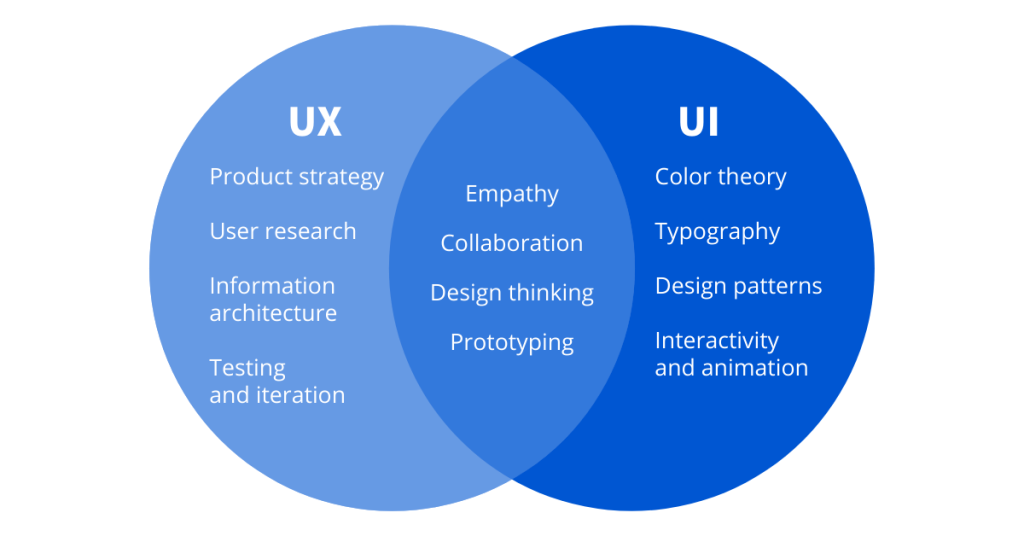
For many years, a paradigm including what large software corporations deemed as helpful tools drove software programming and related product development. Subsequently, smaller development teams and companies started creating programs that appealed a little more to various interests with the introduction of open and shareware. This divided the software market into four categories: gaming, database administration, specialist technical tools, and office productivity.
Then the Internet became widely accessible, especially with browsers, and the paradigm shifted once more. These days, desktop and mobile devices might get digital goods and programs that offer the same features but with significantly distinct user interfaces and controls. User interface and experience (UX/UI) are the main factors that explain why there is such a wide range of differences and why certain apps do so well. We’ll discuss all things UX/UI including our UI/UX design course.
UI: Where Form and Function Collide
Consider the Apple iPhone, for instance. It has a small number of mechanical buttons and no keyboard. Rather, a button for on/off power, another for volume, and a central button for confirmation are used by the user to control the device. Everything else is done by actual fingertip and screen contact. Programs designed for the iPhone must adhere to the same specifications.
How come? Steve Jobs was largely responsible for the design of the iPhone, with a particular emphasis on the user interface’s intuitive features. The user should not need a manual, a PDF file, a video, or any other form of training to figure out how to use the phone. At the time, phones still featured tiny keyboards and toggles, thus this was a departure from the norm (think Blackberry). Rather, Apple was driven to continuously improve through better performance, a more straightforward design, and a less complicated user interface. Not surprisingly, the iPhone remains the most sought-after mobile gadget.
User Experience Is Not Just About Comments
In keeping with the introduction, test groups and user acceptance assessments are frequently used by software testers and designers to improve or complete new digital products. These loopback meetings, though, are really feedback. They skip over the essential elements of user experience, or UX. Steve Jobs’ response to how users are satisfied with a digital device and the software it displays—whether it be an app or the Internet—is the aim of user experience (UX).
User experience is concerned with what makes a software or app perform well for the user and encourages them to return time and time again. Sometimes all it takes is gamifying an app and offering users a contest-win incentive to motivate them. On the other hand, user experience then concentrates on how to make an application easier to use for functional tools that are relevant to the workplace or processing useful information for other activities. As a lot of the user experience is based on the ability to use a program successfully and, more importantly, as intended, this might also involve user accessibility.
Think of a well-known graphics and photo program such as Photoshop. It has amazing power. However, the program has an extremely steep learning curve. It contains a plethora of menus and submenus to modify and add effects to a particular software. To get effects to operate as intended, one must also study and master the layering variations of an image. This type of program is particularly difficult to translate to a mobile app, and if it is overly complex, there is a good chance that the user experience will be subpar.
However, a program like Procreate generates an app solution that is comparable and functions incredibly well on mobile devices. It also manages photos with varying layers and contains strong graphic editing capabilities, yet the user shell tool option features make access and operation simple. It should come as no surprise that Procreate is preferred over Photoshop by users on tablets and phones. Instead of only user interface design, this is caused by user experience. Determining and influencing the factors that lead to users’ happiness or satisfaction with an app becomes the objective.
The Course Material for UX/UI
The aforementioned is broken down into usable learning content with targeted skill set accomplishments and templates in a UI/UX design course. But in contrast to coding, which is primarily concerned with syntax, input, and output, UX/UI is more concerned with how well a user interacts with the application than with how poorly. As a result, research instruments, questionnaires, feedback loops, user recommendations, and concept testing are used to hear what people have to say.
Students that participate in the program are also reminded of the limitations of architecture; after all, you can’t create an experience that the technology available can’t handle. The tool itself continues to be its limitation.
By using wireframing techniques and design revisions to put concepts on paper, students also learn the importance of design-build. Driven by inspirations from UX, flowcharts have evolved from napkin sketches to full-blown design layouts and procedures.
Expectations for a Career
With more and more material being transported to the Internet, UI/UX roles are becoming more and more relevant. People’s ability to navigate around apps and websites has a growing impact on how they use those resources and how they consume information. Because of this, software layouts and web designs today focus far more on adaptability and removing barriers to utilization than they did on merely acting as a gateway.
Businesses have also been emphasizing accessibility a lot, which is very much related to UX/UI. For a moment, let’s say that a user has Parkinson’s disease. It gets quite difficult to hold one’s hand steady physically. Thus, among other things, a web or software design that primarily relies on a mouse or cursor for control might be excruciating for this type of user.
Rather than relying solely on precise placement of the pointer, a responsive UX approach would account for this problem and provide a website or application that offers far more control through a keyboard or something similar, or at the very least, larger controls.
Accessibility is becoming a major factor in UX/UI design for site preparation, particularly in the area of public website design. It is anticipated that this kind of professional influence on UX/UI roles will persist over the next ten years as the drive toward digitalization picks up speed.
Discovering Purpose in Digital Construction
So, the UX/UI area may be quite rewarding for those that want to accomplish more with tech than merely practical solutions. In-person interactions with customers and users, research possibilities, software and online distribution tailored to certain audience demographics, and innovative approaches to improving the current state of the digital world are all made possible by training in UX/UI concepts. To begin your new professional path with LearningFuze, click here!





